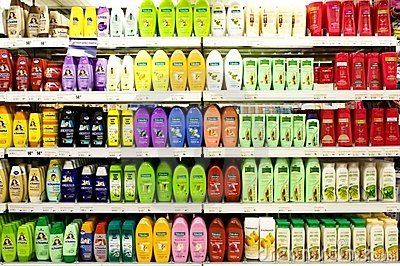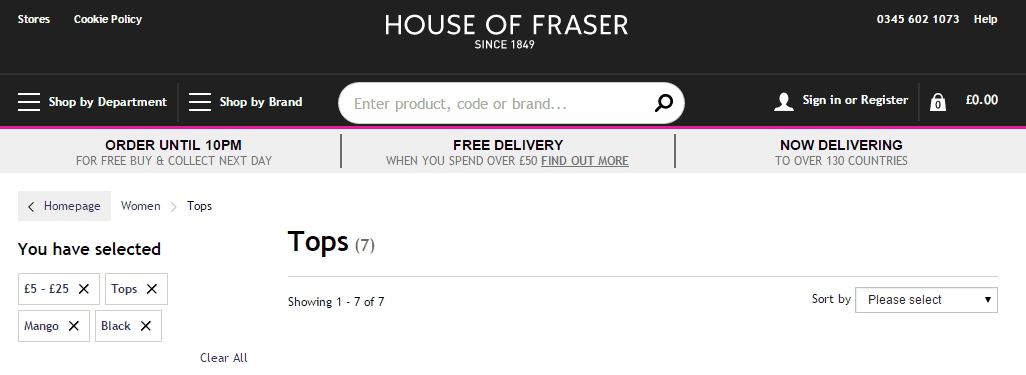Choice is a good thing, right?
 Let us take you back to the grand old days of grocery shopping, when butter came weighed out in a scoop, the grocer knew your children’s names and your favourite cut of beef, and a brand was something you applied to a cow’s bum (not too different to shopping in Lidl today, one might imagine).
Let us take you back to the grand old days of grocery shopping, when butter came weighed out in a scoop, the grocer knew your children’s names and your favourite cut of beef, and a brand was something you applied to a cow’s bum (not too different to shopping in Lidl today, one might imagine).
Limited choice made shopping a simpler experience in those days ('You can have any colour as long as it's black'), but surely the huge array of brands, products and quantities available in today’s supermarkets make shopping a more satisfying experience? After all, what brunette with frizzy hair and split ends could argue against a shampoo product made specifically to meet her needs?
What's the impact of choice on consumer purchasing and ecommerce?
However, as previously demonstrated in our series of articles on digital psychology, the obvious answer isn’t always the right one when it comes to human behaviour. Excessive choice has been shown in numerous studies to result in consumer dissatisfaction, due to our limited capacity for processing information. This leads us to adopt sub-optimal heuristics (rules of thumb) for decision-making, which may ultimately lead to demotivation and lack of action at the point of purchase, a lack of motivation in task completion, reduced task performance, dissatisfaction and post-choice regret.
These negative reactions to a seemingly positive scenario (an abundance of choice) have been termed by renowned American psychologist, Barry Schwartz, as a 'Paradox of choice' (check out his fascinating TED talk here).
In this post, we will investigate how this paradox was first discovered, how it affects ecommerce retailers, and how the paradox’s effects can be mitigated.
When does too much choice occur, and is this ‘too-much-choice’ effect reflected online as well as in offline consumer environments?
If, as Barry Schwartz in his ‘Tyranny of Choice’ paper states, 'As the number of choices we face increase, the psychological benefits we derive start to level off… Some of the negative effects of choice… begin to appear and rather than level off, they accelerate. (Schwartz, 2004)', where is that point?
George Miller's Experiments on information processing
This question was first addressed in 1956 (in an offline context) by the wonderfully verbose George Miller (whose CV reads like an academic prospectus for the world’s greatest research institutions, having taught at Oxford, Harvard, MIT and Princeton).
Miller’s paper entitled 'The magical number seven, plus or minus two: some limits on our capacity for processing information’, discussed findings from a number of experiments on information processing capacity limits in humans across several sensory elements.
His research concludes that the capacity to process ‘bits’ of information in humans was at, or around the 6-7 mark, although there is slight variation dependent upon the context. Miller refers to amounts over this as ‘information overload’.
Herbert Simon's views of 'Maximisers' and 'Satisficers'
Working in parallel to Miller at Carnegie Mellon University, Herbert Simon was developing the concept of ‘satisficers’ and ‘maximisers’ as a means of categorising human’s approach to choice stimulus.
Simon points out that humans are incapable of fully processing overwhelming amounts of information and that some, which he termed satisficers (satisfaction through sacrifice = satisficing), adopt heuristics to deal with this. These satisficers decide upon an acceptable level across attributes, choose the first option passing that acceptance threshold, and stop searching.
Other humans (maximisers), regardless of innate limits, strive to ‘find the best’, seeking to consider all possible options, in an impossible task, before making a choice (maximising).
Borrowing the terms ‘maximisers’ and ‘satisficers’ from Simon, Schwartz later categorized thousands of people as either maximisers or satisficers using a ‘maximisation scale’.
Schwartz claims maximisers are less satisfied and more regretful post-decision and that more choice is worse than fewer for them. ‘Maximisers’ are unable to cope with being unable to evaluate all options and deal with the opportunity costs of ‘loss of alternatives’. Furthermore, the more options there are, the higher the search costs in terms of time (and arguably money (loss of time)).
Applying Psychology to a chocolate test
To demonstrate these principles in action, let’s look to the world of gourmet chocolates, via Iyengar & Lepper’s 2000 study of demotivation through excess choice. In this psychological study (masked as a market research piece to avoid biasing the results), students from Columbia University were presented with a selection of either 6 or 30 luxury chocolates to evaluate.
The students presented with the lower quantity amount consistently rated their chocolates higher, and as an extra twist to the tale, when offered chocolate in lieu of financial remuneration, the students evaluating the limited choice of chocolates were four times more likely to accept the ‘chocolate money’ as payment.
A more contemporary study, conducted by this article’s joint author, Dawn Anderson, of Move It Marketing, surveyed 100 participants, aiming to qualify the ‘magic number’ for customer choice, originally suggested by Miller.
Study's hypothesis
The study hypothesized that respondents would prefer fewer options in a shop or supermarket environment, but would choose more options when in an online environment, due to the advanced range of filters that are available online. The study also explores the effect of single option availability on buyer satisfaction.
Respondents were asked a series of multiple-choice questions, one of which contained images of jam assortments (designed to partially replicate a similar ‘Jam Study’ carried out by Iyengar and Lepper in 2000.), boolean option questions, and one free numerical entry text question.
Results of the study
The study found that overall, participants had no aversion to a single option display and that 6 jams proved the preferred assortment size (see figure 1). As the assortment size increased, a clear pattern emerged, with popularity inversely decreasing. Whilst participants claimed to not find comparing large selections online either more comfortable or easier than offline, further answers to questions did not correspond with this.
Figure 1 – when asked how many options participants would prefer to choose from

If you’d like a full copy of Dawn’s research, please drop her a line. Contact details are available at the end of this post.
These findings suggest that our human brains, both off and online, just haven’t evolved to deal with choice; understandable, when we consider that supermarkets have only been in existence for a few decades, compared to the hundreds of thousands of years of human evolution that relied on the “I’ll take what I can get” method employed by hunter gatherers.
Excess choice ultimately leads to anxiety, and the brain begins to focus not on what it has, but instead on what it doesn’t have. The greater the sacrifice, the more dissatisfaction is felt.
Reviewing how ecommerce companies are handling consumer choice
How does it work with Amazon?
In ecommerce, this dissatisfaction is amplified thanks to the use of endless aisles. In the high street, even the largest of stores display finite stock due to limitations on floor space, but virtual space is infinite, and as such, when a user searches for 'dresses' on Amazon, they are accosted with 853,694 separate options.

So, as responsible digital marketers, how can we alleviate our customer’s anxiety, and increase their product satisfaction by reducing choice?
Product filtering is key
Having looked to Amazon for the problem, let’s take another look for the solution. Through necessity, Amazon have embarked on an increasingly granular approach to product filtering, allowing users to layer filter upon filter to reduce the overwhelming product range that they are initially exposed to.
Amazon also make use of ‘smart’ filters, which are category specific, adapting as user’s search for different products. Let’s take a search for 'child seats’ as an example. Gone are the colour and size filters offered to dress buyers, to be replaced by seat weight restrictions and child seat safety features.
If the ‘too much choice’ phenomenon occurs as a result of complexity rather than mere volume then marketers may need to consider how best to assist the consumer in choosing, via categorisation, product tagging and in-site search.
Etsy's strategy for managing consumer choice
Homemade goods retailer, Etsy combines these three elements to great effect, resulting in a superior user experience that enhances both browsing, buying and post purchase satisfaction.


Alas, Etsy fails to capitalise on these really useful filters (we particularly like the free form tags) as there is no way to layer them – meaning that even the most obscure tags (“native American girl” anyone?) still return an unusable number of results, that cannot then be sub-filtered.
House of Fraser's UX
This is where House of Fraser’s UX really shines. Their filters can be layered on top of each other, to quickly and efficiently reduce the number of options presented to the consumer.

House of Fraser’s filters are clearly displayed at the top of the results page, and can be added/removed ad hock.
By quickly reducing the number of options available into bite size chunks, House of Fraser are reducing consumer anxiety, and enhancing the online experience; and all this achieved by a retailer that sells a complex product range, with everything from luxury women’s apparel to food blenders available online.
Now it’s your turn to reduce your website user’s choices online. Less really is more when it comes to your customer’s satisfaction.
This is the third post in our series by Andrew on applying psychology to improve digital experiences and campaigns. See Andrew's first post on digital psychology - using reciprocity to trigger customer loyalty and second post on using confirmation bias to generate increased retention and spend. If you would like to find out more on the subject, feel free to drop Andrew and team a line, or watch their video on digital psychology.
 Thanks to Andrew Nicholson and Dawn Anderson for sharing their advice. Dawn is a Digital Marketing Consultant from Move It Marketing and Andrew is the founder of digital psychology and marketing consultancy, The Guku. You can follow Andrew on Twitter, connect on LinkedIn or follow Dawn on Twitter.
Thanks to Andrew Nicholson and Dawn Anderson for sharing their advice. Dawn is a Digital Marketing Consultant from Move It Marketing and Andrew is the founder of digital psychology and marketing consultancy, The Guku. You can follow Andrew on Twitter, connect on LinkedIn or follow Dawn on Twitter.



 Let us take you back to the grand old days of grocery shopping, when butter came weighed out in a scoop, the grocer knew your children’s names and your favourite cut of beef, and a brand was something you applied to a cow’s bum (not too different to shopping in Lidl today, one might imagine).
Let us take you back to the grand old days of grocery shopping, when butter came weighed out in a scoop, the grocer knew your children’s names and your favourite cut of beef, and a brand was something you applied to a cow’s bum (not too different to shopping in Lidl today, one might imagine).




 Thanks to
Thanks to 


